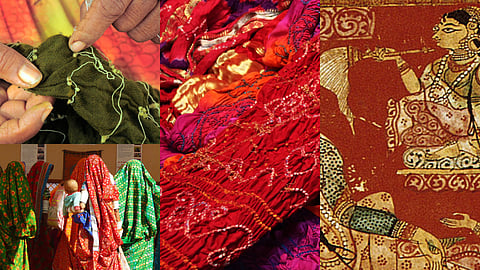Ahmedabad Market Finds| Know about Bandhani, Gujarat’s heritage textile & a wardrobe must-have
Ahmedabad and many parts of Gujarat are famed for their rich textile industry. One of its most loved crafts is Bandhani. Known for its eye-catching dots, complex patterns, and dazzling colours, it has been an emblem of Gujarati heritage for centuries. Bandhani holds a special place in both traditional and contemporary fashion and is deeply embedded in ceremonies, particularly weddings, where Bandhani sarees are symbols of prosperity and joy.
In traditional Gujarati weddings, Bandhani plays a central role. Brides wear the iconic Panetar, a white sari with Bandhani-dyed red borders, symbolizing purity and new beginnings. During the ceremony, the bride is also gifted a Gharcholu—a red and white Bandhani sari adorned with gold checks—as a blessing from her in-laws, symbolizing her new journey. This ceremonial attire isn’t just a piece of cloth; it’s a tangible connection to culture and family, often passed down through generations.
Bandhani in making: The tie and dye technique
The word "Bandhani" comes from the Sanskrit word "bandh", which means “to tie.” Bandhani is made by carefully tying tiny sections of fabric with thread and then dyeing it.
The areas tied with thread resist the dye, creating unique patterns once the ties are removed. Sometimes, the fabric is tied and dyed in multiple rounds to create intricate designs. The result is a vibrant fabric with small circles, dots, or shapes, adding a unique beauty and texture that makes each Bandhani piece one-of-a-kind.
While Bandhani remains rooted in tradition, it has also adapted to modern styles. Apart from saris, you can now find Bandhani in dresses, scarves, bags, and even home decor items like cushion covers.
Ancient history dating back to Indus Valley Civilization!
Bandhani has roots in the Indus Valley Civilization (circa 4000 B.C.), where dyeing techniques first emerged. Some of the earliest visual evidence of Bandhani-style dots appears in 6th-century Ajanta cave paintings, depicting vibrant, dotted garments. During Alexander the Great’s era, records admired India’s unique printed cottons, indicating Bandhani's deep cultural significance.
In India, the Khatri community of Gujarat is credited with refining and popularizing Bandhani, especially in Gujarat and Rajasthan. Traditionally, Bandhani saris were worn in royal ceremonies, with the belief that they brought good fortune to brides, as noted in Bana Bhatt's "Harshacharita".
Over time, places like Jamnagar in Gujarat and Jaipur, Udaipur, and Bhilwara in Rajasthan became prominent centres for Bandhani production, where each region developed its unique styles.
Knock Knock!
So, whether you're visiting Ahmedabad, exploring other parts of Gujarat, or you’re a proud Gujarati yourself, adding a piece of Bandhani to your wardrobe is like owning a slice of Gujarat’s rich heritage. Each Bandhani piece isn’t just a beautiful textile—it's a work of art, meticulously crafted to carry stories of culture and tradition that span generations!
Where to find Bandhani in Ahmedabad
Ahmedabad offers a variety of places to shop for Bandhani. Visit Ratan Pol for a variety of options Bandhani sarees, dupattas, and dress materials. Boutique stores like Bandhej are ideal for contemporary designs, while Mangalya Bandhani Sarees, VANZA BANDHANI, and Khatri Jaybhai Bandhaniwala are known for authentic and intricate hand-dyed Bandhani pieces. These options cater to all preferences, from traditional to modern styles!
To get all the latest content, download our mobile application. Available for both iOS & Android devices.

